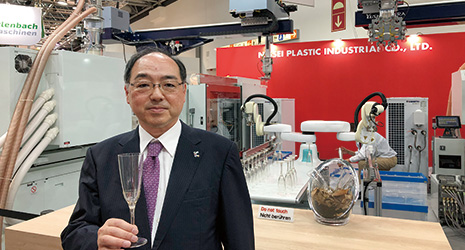Home > Highlighting JAPAN > Highlighting Japan November 2019 > Science & Technology
Highlighting JAPAN


Low-Cost Bioplastic to Reduce Plastic Waste
A Japanese company has developed a technology for mass-producing biodegradable plastic products at low cost which is attracting attention around the world.
Many plastic products made from oil, including PET bottles and food trays, can be found all around the world. Disposal of these plastics affects ecosystems because if they are burned, they contribute to global warming, and if they flow out into the sea, they create marine litter and microplastic pollution. The World Economic Forum announced in 2016 that by 2050, the amount of plastics drifting in the sea around the world is projected to surpass the amount of fish in terms of weight.
In this situation, biodegradable plastics are attracting attention as a replacement for the current plastics made from oil. Biodegradable plastics are considered to lessen the environmental load because they are ultimately decomposed into carbon dioxide and water by microorganisms in the natural world. Polylactic acid, one of the biodegradable plastics, which is made from corn starch or sugarcane, began to be used as a material for products such as dishes and garbage bags about twenty years ago. But polylactic acid was so hard to process and polylactic acid products were so expensive that they did not become popular at all.
Komatsu Michio, the president of Komatsu & Associates, a professional engineer’s consulting firm in Iwaki City, Fukushima Prefecture, overcame the processing challenges and developed a technology of mass-producing polylactic acid products at lower cost than by using existing methods. The main reason why polylactic acid is hard to process is that it is far more viscous than plastics made from oil. Generally speaking, to process plastics, people use the processing method called injection molding, which involves heating and melting plastics, injecting the molten plastics into a mold, putting them into a shape, waiting for them to cool down and solidify, then ejecting them from the mold. In the case of highly viscous polylactic acid, however, the materials do not flow to the end of a mold cavity by normal injection molding, and the article cannot be molded well.
To solve this problem, Komatsu focused his attention on a super critical phenomenon. Matter can exist as a solid, liquid or gas according to the temperature and pressure conditions. But if you keep applying pressure and heat to matter, it will enter a super critical phase in which it is indistinguishable from a gas or a liquid.
“Matter in a super critical phase is called super critical fluid and has both the diffusiveness of a gas and the solubility of a liquid. By mixing carbon dioxide in a super critical phase into melted polylactic acid, we succeeded in increasing the fluidity of polylactic acid,” explains Komatsu.
Molding polylactic acid had another significant issue. Ordinary plastics gradually solidify when they cool down, whereas a heat-resistant grade of polylactic acid contracts rapidly when it reaches a certain temperature. Once it reaches this state, it is caught in the mold core and impossible to eject. Because of this, it takes a lot of time and effort to get the molded article out, and they cannot be produced at the same pace as ordinary plastics.
Komatsu also overcame this issue by making use of his experience of working as a mold expert for a leading electronic parts manufacturer.
“I put an infrared temperature sensor in a mold and measured the temperature of the polylactic acid in units of thousandths of a second. After repeating the measurements many times, I found that as soon as the temperature falls to 110˚C, the polylactic acid begins solidification. I found that the polylactic acid could be detached easily by capturing that timing and injecting air into the gap between the mold and the polylactic acid article,” says Komatsu.
By using the technology developed by Komatsu, a company based in Aichi Prefecture succeeded in mass-producing tableware for babies that had good heat resistance and strength. In January 2018, Komatsu won the Prime Minister’s Award at the Seventh Monodzukuri Nippon (Japan’s Manufacturing) Grand Award, which is granted to individuals or groups with advanced technology in the manufacturing industry. The developed technology acquired numerous patents around the world.
In January 2018, the European Union (EU) proposed putting an all-out ban on all inter-regional disposable plastic containers by 2025 and declared that it would aim to make all inter-regional plastic packages recyclable by 2030. The demand for biodegradable plastics as materials to cope with these environmental regulations is expected to grow. Orders for the biodegradable baby tableware are pouring in from overseas, including Europe, as well as from around the country.
“We still have an issue in terms of the high material costs. But we have recently seen an increase in the number of polylactic acid manufacturers and production volumes, which leads to lower costs. In this situation, I think that products using polylactic acid will gradually become popular. I will be extremely happy if the technology I developed helps preserve the natural global environment,” says Komatsu.
© 2009 Cabinet Office, Government of Japan









